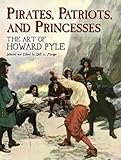First off, Pyle used fugitive ink to write this one, or else the ink was pale or diluted to begin with. Also, although the letter is dated August 26 - a Saturday - the envelope is postmarked 10 p.m. August 28. So there’s a chance he got the date wrong (not unusual for him), or he missed Saturday’s mail and couldn’t mail it Sunday, then forgot to post it until late Monday, or some such scenario. Pyle was 23 years old, then, and living with his parents at 917 Market Street in Wilmington; presumably he wrote the letter there.
The addressees are the Misses Alice and Sallie Cresson. Alice Hannum Cresson was born December 24, 1848, in Philadelphia. In 1876 she was living with her parents, Walter and Alice (Hannum) Cresson, and sisters, Anna and Sarah, in Conshohocken, Pennsylvania. Alice’s maternal aunt, Hannah Hannum (1817-1896), had married Pyle’s uncle, John Painter (1824-1865), in 1845, so the “cousins” probably met as children. Sarah (Sallie) Cresson was born June 16, 1852, and closer in age to Pyle, but Alice seems to have interested him more: five of the six letters from this series are addressed solely to her. It’s not clear, though, if Pyle’s interest was romantic: his tone tends to be playful, sometimes flirty, but never ardent - except in jest.
In summertime, Pyle and various relatives and friends would often escape the confines of Wilmington for “Mansion Farm” in Owings Mills, Maryland. The four hundred acre estate on the Reisterstown Turnpike belonged to Pyle’s uncle, Milton Painter (1815-1888), and for many years it was the site of sundry family gatherings. The Delaware Historical Society has a great photograph taken on one of these summer outings of Pyle standing amongst - and towering over - a crowd of young folk (perhaps including the Cresson sisters) in the nearby woods.
The “Cameron” Pyle mentions was James H. Cameron, who lived with his father Dr. John Cameron, at 819 West 4th Street, Wilmington. Like Pyle, Cameron was a tenor, a Swedenborgian, and a member of the Friends’ Social Lyceum. He also took part in events organized by Pyle’s mother, including poetry readings and tableaux.
So here’s my transcription:
Wilmington Aug 26th / 76
Miss Alice & Sallie:
Dear Ladies:
“We note the passage of our life by its losses and neglects”; says a certain author, so do I recollect with real regret, my failure to meet you on your way home from Maryland.
Very possibly, - probably; perhaps it may be to you a matter of the utmost indifference; unfortunately for myself, I cannot look at it in that light; and I assure you frequently breathe words, I hope you never use, against that miserable engagement that detained me at the Newspaper Office, until half past one on that Tuesday when you passed through Wilmington.
I am in regard to the sentiments of my regret, very similar to the old fellow who when his wife died; with tears in his eyes thus expressed himself. “I have had many losses! I have lost crops; I have lost chickens; I have lost pigs; but I never had a loss like Maria!”
There is something rather comfortable in performing ones duty, and there is something decidedly comfortable in taking ones pleasure; but when they come upon one in conjunction, and opposed to each other; they produce an effect metaphorically speaking like good salt, and good coffee; which try and you will appreciate!
So was I situated when duty called me to make a visit to Chincoteague, and pleasure to Maryland, and many times when the mosquitoes were particularly troublesome, and the weather uncommonly hot; and when I contrasted my uncomfortable lot with the pleasant times I might have enjoyed in Maryland, I vowed to myself never in future to give duty the priority of position with pleasure.
You can believe; my dear ladies, that my cheerfulness was not at all heightened, when I, whilst desperately fighting mosquitoes, pictured to myself Cameron, sitting radiently on the gate-post; or when plowing hot, cross, and perspiring, through the shifting sand of Chincoteague, I saw in my imagenation all of you sitting, cosily chatting over your ice cream, on the shady breezy poarch [sic] of Mansion Farm. I was like starving Tantalus, whose misery was heightened by seeing the fruit he could not reach.
And so I have meandered dolefully to the close of my complaining letter; - pity ladies my disappointments of this summer! and believe me as ever
Yours Most Respectfully
Howard Pyle
“Disappointments,” indeed! Although Pyle disparages his Chincoteague trip, the article born out of it was key to his transitioning from clerk (or salesman, or whatever he was) in his father’s leather business to professional artist-author. At this very time, his “Chincoteague, Island of Ponies” was accepted for publication in Scribner’s Monthly and, as some of his illustrated fables had also been accepted by St. Nicholas, Pyle finally “felt my art was of some practical use. This was confirmed by Mr. Roswell Smith, who advised me through my father...to come to New York.”
All well and good. But what about “that miserable engagement that detained me at the Newspaper Office, until half past one on that Tuesday”? I’ll answer that in my next post.

































